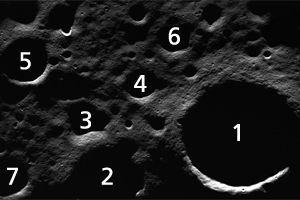Okay, that was the sales pitch, here are some details.
Count some stars! Subject: stars visible to the naked eye; what's being investigated: the impact of urban light pollution on our access to the simple wonders of the night sky. Every year, Windows to the Universe conducts the Great Worldwide Star Count citizen science project, enabling anyone who can look up at the night sky and count some of the stars there to participate in real science. We're already into the Count, which runs this year from October 31st through November 12th. For details on how to participate, check out their website.
Results from the Great Worldwide Star Count are presented in a global map showing the "limiting magnitude" from thousands of locations where citizen scientists observed. The limiting magnitude is a measure of brightness of the faintest star that can be seen from a given location.
How about craters on the Moon? Looking at the Moon through a small telescope, you can count some of the largest craters—those that are typically at least a mile or so across. By virtue of the powerful LROC camera on NASA's Lunar Reconnaissance Orbiter (LRO), the surface of the Moon is rabidly being photographed to a level of detail that reveals craters as small as a foot and a half across!
Craters are a fantastically rich source of information regarding the history of our solar system, each one a record of a single meteoroid impact which, when examined in context with all the rest, allows scientists to forensically piece together the puzzle of the formation of the Moon and our region of the solar system.
While there are estimated to be at least 300,000 lunar craters with diameters of about half a mile or greater on the side of the Moon facing the Earth, smaller craters are estimated into the millions, and microcraters are most likely uncountably common.
This means science needs your help! And you can give it, at Moon Zoo. Log onto the Moon Zoo website, register yourself as an official lunar explorer, and have at it, friend. Examining LRO images of the Moon's surface, you will count and classify craters and boulders, and mark unusual and interesting lunar features, as you explore. There are so many images that have been acquired by LRO that in many cases you will be the first person ever to lay eyes on the particular patches of the Moon you examine—you might even run across something remarkable, like a derelict lunar robot from the 1960s (it's happened!). Best of all, your work will count, your data feeding into a growing database from Moon Zoo explorers all over the world.
A sibling site to Moon Zoo—Galaxy Zoo—lets you examine and classify galaxies imaged by the Hubble Space Telescope. And since there are millions upon millions of unclassified galaxies that have been caught in Hubble's telescopic net, you'll be covering unexplored territories of space and contributing to our planet's understanding of the Universe….
There's a lot of work to do out there, and the glittering treasure trove of data just keeps getting larger and larger—so get to work!
37.8148 -122.178
 Counting craters on a Lunar Reconnaissance Orbiter image
Counting craters on a Lunar Reconnaissance Orbiter image 